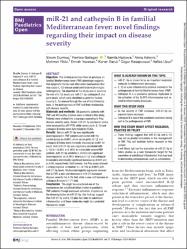miR-21 and cathepsin B in familial Mediterranean fever: novel findings regarding their impact on disease severity

Göster/
Erişim
info:eu-repo/semantics/openAccessTarih
2025Yazar
Durmuş, SinemGelişgen, Remise
Hajiyeva, Ramila
Adrovic, Amra
Yıldız, Mehmet
Yücesan, Emrah
Barut, Kenan
Kasapçopur, Özgür
Uzun, Hafize
Üst veri
Tüm öğe kaydını gösterKünye
Durmus, S., Gelisgen, R., Hajiyeva, R., Adrovic, A., Yildiz, M., Yucesan, E., Barut, K., Kasapcopur, O., & Uzun, H. (2025). miR-21 and cathepsin B in familial Mediterranean fever: novel findings regarding their impact on disease severity. BMJ Paediatrics Open, 9(1), e003064. https://doi.org/10.1136/bmjpo-2024-003064Özet
Objective The limited predictive effect of genotype on familial Mediterranean fever (FMF) phenotype suggests that epigenetic factors and alternative mechanisms that may cause IL-1 beta release could contribute to phenotypic heterogeneity. The objective of this study was to examine the role of IL-1 beta levels and miR-21-5p, cathepsin B and pyrin levels, which were identified as potential factors causing IL-1 beta release through the use of bioinformatics tools, in the pathogenesis of FMF and their relationship with disease severity. Materials and methods 50 paediatric patients with FMF and 40 healthy children were enrolled in this study. Patients were divided into subgroups according to Pras disease severity score. Serum miR-21-5p expression levels were assessed by qRT-PCR, while serum pyrin, IL-1 beta and cathepsin B levels were determined by ELISA. Results Serum miR-21-5p was significantly downregulated in FMF patients compared with the control group (p<0.001), while serum pyrin, IL-1 beta and cathepsin B levels were markedly elevated (p<0.001 for each). Only miR-21-5p was negatively correlated with IL-1 beta (r=-0.855; p<0.001). In moderately severe FMF patients, miR-21-5p exhibited a statistically significant downregulation (p<0.001), whereas IL-1 beta and cathepsin B showed a statistically significant increase (p<0.001 and p<0.05, respectively). Furthermore, the Pras score showed a strong negative correlation (r=-0.738; p<0.001) with miR-21-5p levels. Multivariate logistic regression showed that in FMF, a one-unit decrease in miR-21 increased disease severity risk 6.76-fold, while a one-unit increase in cathepsin B raised it 1.71-fold. Conclusion This might be considered one of the mechanisms for subclinical inflammation in paediatric FMF patients through increased activation of cytokines via the downregulation of miR-21-5p. Our findings suggest that miR-21-5p and IL-1 beta play key roles in subclinical inflammation, and these molecules might be a potential therapeutic target.
















